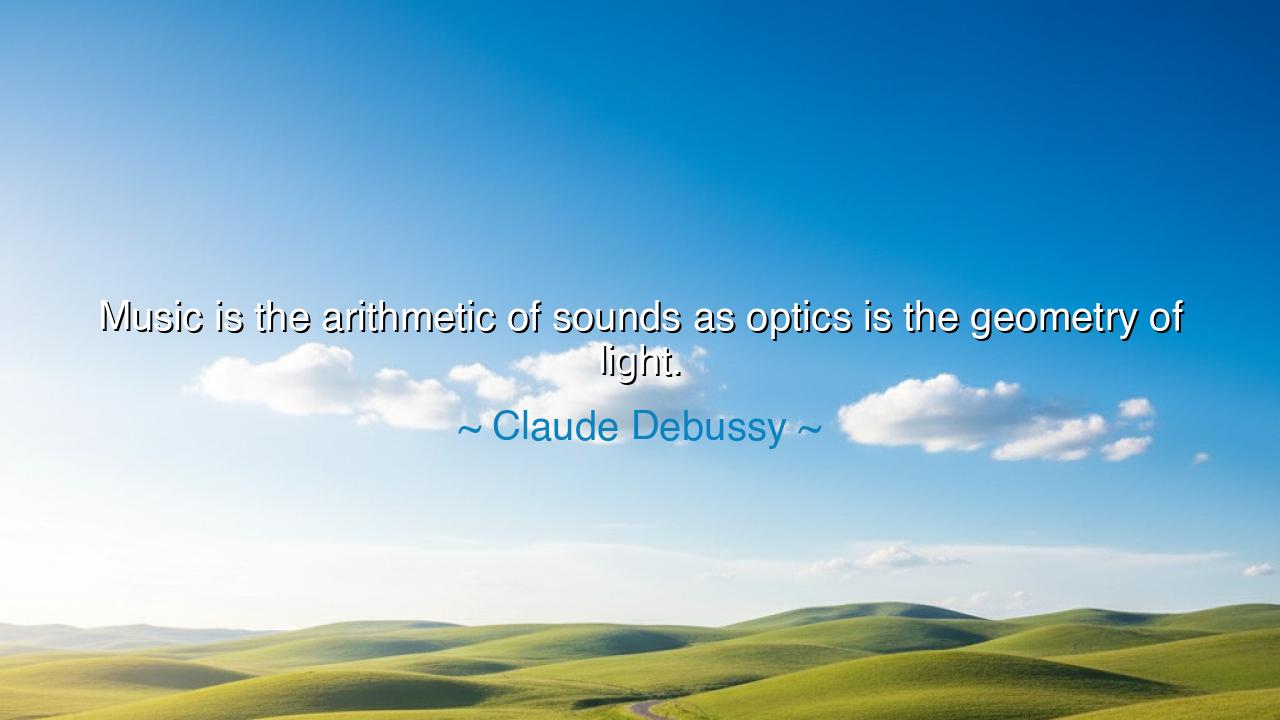
Music is the arithmetic of sounds as optics is the geometry of






Hear the words of Claude Debussy, the dreamer of tones and painter of sound, who declared: “Music is the arithmetic of sounds as optics is the geometry of light.” In this saying, he unveils the hidden architecture of the universe, where art and science are not enemies but kin. For just as numbers and proportions govern the harmony of the stars, so too do they govern the rhythm of notes and the resonance of chords. Music is not chaos—it is order, made alive; it is mathematics clothed in emotion, just as light is geometry clothed in color.
To call music “the arithmetic of sounds” is to reveal that melody and harmony are bound by laws as precise as the laws of the heavens. Ratios determine intervals, vibrations form scales, and patterns shape rhythm. Behind every song lies a structure, a pulse that can be measured and understood. And yet, when this arithmetic is set free, it becomes more than calculation—it becomes beauty. Thus, Debussy reminds us that even the most ethereal art has roots in eternal order.
Likewise, to call optics “the geometry of light” is to recognize that vision, too, is governed by proportion and structure. The bending of rays, the angles of reflection, the harmony of colors—all follow laws of number. Just as music brings order to sound, optics brings order to sight. Both reveal that beauty is never far from truth, and truth is never far from beauty. In both, the soul perceives harmony because creation itself is ordered in harmony.
Consider the life of Pythagoras, the ancient sage who first discovered that the pleasing intervals of a lyre’s strings could be expressed in numbers. From his hands came the revelation that the universe itself is music—that the planets move in celestial harmony, their motions echoing the same laws that shape song. Debussy, centuries later, stood in this same lineage, seeing not division but unity: the world of art and the world of science woven together by proportion.
But Debussy was not only a man of theory—he was a man of emotion, of shimmering impression. His own music often defied rigid form, flowing like water and light. And yet even in this freedom, the hidden arithmetic remained. His harmonies, though daring, were not lawless; his soundscapes, though unbound, still obeyed unseen order. In this way, his words are a paradox and a truth: music is both number and mystery, both calculation and spirit.
The lesson is profound: to create, one must honor both structure and inspiration. The mathematician who despises beauty will never see the poetry of numbers. The artist who despises structure will never sustain their creation. But he or she who unites both—order and freedom, science and art—will touch the eternal. For the world itself is built on this union: laws that give rise to beauty, order that blossoms into wonder.
Practical actions follow. If you are an artist, study the structures beneath your craft—learn the scales, the proportions, the techniques that give stability to inspiration. If you are a thinker, do not neglect the beauty that gives meaning to truth. Listen to music not only with your heart but with your mind, and look at light not only with your eyes but with your soul. Practice living with both reason and passion, for in their union lies greatness.
Thus the wisdom of Debussy endures: “Music is the arithmetic of sounds as optics is the geometry of light.” These words remind us that beauty is not random, and truth is not dry. They are two faces of the same coin, two languages of the same creation. To walk in their harmony is to live not only with knowledge, but with wonder, not only with order, but with song.






AAdministratorAdministrator
Welcome, honored guests. Please leave a comment, we will respond soon